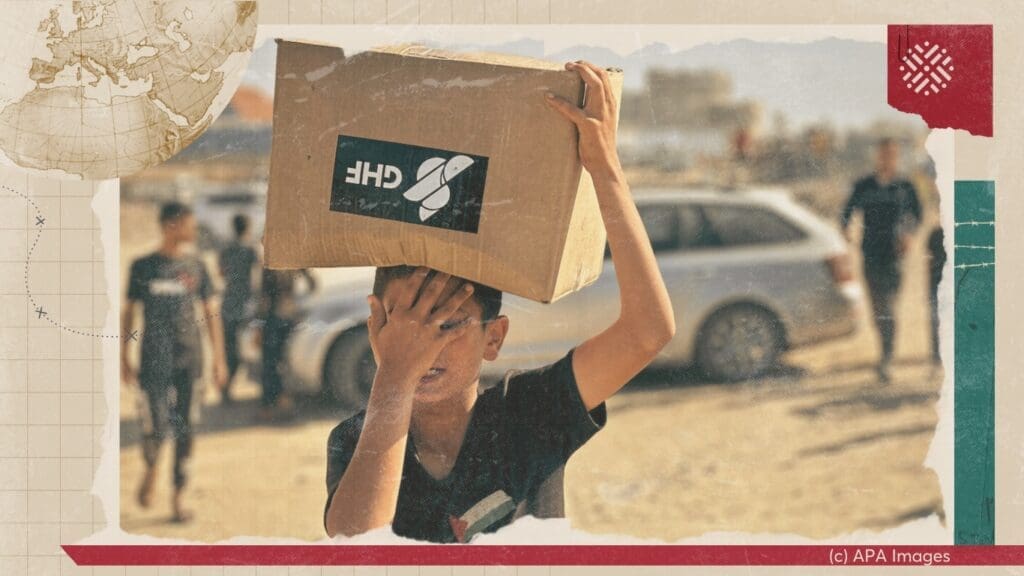- Topics
-
Topics
See our analysis on civil society and how it shapes culture, politics, and policies
Read our insights on the shifting political landscape and what it means for Palestine
Learn more about the policies and practices shaping the Palestinian economy
Strengthen your understanding of the unique conditions for Palestinian refugees across the Middle East
-
- Analysis
-
Analysis
In-depth analysis on existing or potential policies that impact possibilities for Palestinian liberation.
Insights and perspectives on social, political, and economic questions related to Palestine and Palestinians globally.
Concise analysis into a specific policy, its background and implications.
Commentary that brings together insights from multiple analysts.
Compilations of past Al-Shabaka works surrounding a specific theme.
Longer-form, ad hoc projects that seek to confront research questions outside the scope of our regular analysis.
A policy-driven research initiative by Al-Shabaka: The Palestinian Policy Network.
Our monthly webinar series that brings together Palestinian experts.
Featured
On Thursday, June 19, 2025, Israeli Prime Minister Benjamin Netanyahu stood in front of the aftermath of an Iranian strike near Bir al-Saba’ and told journalists: “It really reminds me of the British people during the Blitz. We are going through a Blitz.” The Blitz refers to the sustained bombing campaign carried out by Nazi Germany against the UK, particularly London, between September 1940 and May 1941. With this dramatic comparison, Netanyahu sought to elicit Western sympathy and secure unconditional support for his government’s latest act of military escalation and violation of international law: the unprovoked bombing of Iran. This rhetorical move is far from new; it has become an enduring trope in Israeli political discourse—one that casts Israel as the perennial victim and frames its opponents as modern-day Nazis. Netanyahu has long harbored ambitions of striking Iran with direct US support, but timing has always been central. This moment, then, should not be viewed merely as opportunistic aggression, but as part of a broader, calculated strategy. His actions are shaped by a convergence of unprecedented impunity, shifting regional dynamics, and deepening domestic political fragility. This commentary examines the latest escalation in that context and discusses the broader political forces driving it. Yara Hawari· Jun 26, 2025Launched on May 26, 2025, and secured by US private contractors, the new Israeli-backed aid distribution system in Gaza has resulted in over 100 Palestinian deaths, as civilians navigated dangerous conditions at hubs positioned near military outposts along the Rafah border. These fatalities raise grave concerns about the safety of the aid model and the role of US contractors operating under Israeli oversight. This policy memo argues that the privatization of aid and security in Gaza violates humanitarian norms by turning aid into a tool of control, ethnic cleansing, and colonization. It threatens Palestinian life by conditioning life-saving aid, facilitating forced displacement, and shielding the Israeli regime from legal and moral responsibility. It additionally erodes local and international institutions, especially UNRWA, which has been working in Gaza for decades.
Yara Hawari· Jun 26, 2025Launched on May 26, 2025, and secured by US private contractors, the new Israeli-backed aid distribution system in Gaza has resulted in over 100 Palestinian deaths, as civilians navigated dangerous conditions at hubs positioned near military outposts along the Rafah border. These fatalities raise grave concerns about the safety of the aid model and the role of US contractors operating under Israeli oversight. This policy memo argues that the privatization of aid and security in Gaza violates humanitarian norms by turning aid into a tool of control, ethnic cleansing, and colonization. It threatens Palestinian life by conditioning life-saving aid, facilitating forced displacement, and shielding the Israeli regime from legal and moral responsibility. It additionally erodes local and international institutions, especially UNRWA, which has been working in Gaza for decades. Safa Joudeh· Jun 10, 2025In this policy lab, Mariam Barghouti and Sharif Abdel Kouddous join host Tariq Kenney-Shawa to discuss Israel’s targeted assassination campaign against Palestinian journalists, the complicity of Western media in normalizing these crimes, and how this silence allows Israel to get away with genocide.
Safa Joudeh· Jun 10, 2025In this policy lab, Mariam Barghouti and Sharif Abdel Kouddous join host Tariq Kenney-Shawa to discuss Israel’s targeted assassination campaign against Palestinian journalists, the complicity of Western media in normalizing these crimes, and how this silence allows Israel to get away with genocide. Mariam Barghouti· May 28, 2025
Mariam Barghouti· May 28, 2025
-
- Resources
- Media & Outreach
- The Network




The PA’s Revenue Structure and Israel’s Containment Strategy
Overview
The Palestinian Authority’s (PA) budget disproportionately relies on clearance revenues — import taxes collected by Israel on its behalf — that the Israeli regime regularly withholds as political blackmail. As a result, Palestinians in the West Bank and Gaza suffer severe economic consequences.1
This commentary departs from discussions around the effects of Israel’s frequent withholding of clearance revenues from the PA, and instead explores the foundational logic of this arrangement. It argues that the PA’s distorted budget is a reflection of the Israeli regime’s strategy of containing the Palestinian people. That is, the PA’s lack of control over clearance revenues arises because of the contradiction of assigning it fiscal spending responsibilities without political sovereignty, a bizarre arrangement codified in the 1994 Paris Economic Protocol (PEP). With a negligible domestic tax base to offset its unusually high reliance on clearance revenues, the PA remains unable to undergo fundamental fiscal reform. So long as Palestinian leadership lacks control over its borders in the West Bank and Gaza, and other sources of revenue are negligible within a devastated Palestinian economy, transfers of clearance revenues from Israel remain the PA’s economic lifeline. As a result, the PA will also continue to be unable to leverage any real political pressure against the Israeli regime. It is therefore neither meaningful nor productive to speak of fiscal change within the PA without first addressing the Israeli regime’s strategic containment of the Palestinians.
Economic Subjugation by Design
Political Underpinnings
Palestinians have never been in control of their import taxes, neither before nor after the 1993 Oslo Accords. Between 1967 and 1994, when the Israeli military solely administered the West Bank and Gaza, Israel collected taxes on Palestinian imported goods and on all Palestinian income. Furthermore, it used these taxes to finance itself in what was a highly extractive spending system with minimal public investment in Palestinians.
The PA’s revenue structure fundamentally forms the economic underpinning of a de facto no-state solution, whereby Palestinians are allowed neither integration into a binational state nor independence Share on X
Following the PEP, signed as part of the Oslo Accords, the PA became responsible for direct spending on Areas A and B within the West Bank, as well as in Gaza. The Israeli regime continued to control the borders and, therefore, Palestinians’ import-based tax revenues, but was now meant to transfer these revenues to the newly formed PA, which was tasked with public spending.Importantly, East Jerusalem is excluded from this transfer scheme due to Israel’s illegal annexation of the city. Moreover, neither the Fatah-controlled PA, which spends roughly a third of its budget on East Jerusalem and Gaza, nor the Hamas-controlled government in Gaza, are permitted to collect funds from goods imported into Gaza, which has remained under Israeli blockade since 2007. This is made more precarious by the fact that Hamas is funded through PA transfers, regional aid, domestic taxation, and taxes on goods transported through tunnels. Israel’s differential treatment of East Jerusalem and Gaza relative to the West Bank reflects its strategy of dominating Palestinian fiscal structures through elaborate border politics that fall under the rubric of the PEP.In this way, the Oslo Accords allowed Israel to maintain control over Palestinian borders and sovereignty while relieving it of prior administrative responsibilities toward the Palestinians it subjugates in the West Bank and Gaza. Crucially, this arrangement is underpinned by Israel’s refusal to delink from the Palestinians or to integrate them into a binational state, in what amounts to a de facto no-state solution. Indeed, any alternative arrangement whereby the PA is afforded independent collection of customs revenues is not feasible when the political prerequisite of sovereignty over borders is not on offer. Moreover, any alternative that involves Israel directly spending on a Palestinian polity that lacks political rights would entrench the apartheid nature of Israeli containment.
The PA’s Distorted Revenue Structure
It is only in such a contorted political context that a peculiar arrangement can emerge whereby the Israeli regime collects import taxes from the territories it occupies and subsequently transfers these revenues to the local Palestinian body tasked with administering those territories. And since import taxes collected at Palestinian borders form the bulk of the PA’s clearance revenues, its fiscal structure is fundamentally warped with the absence of sovereignty. Figure 1 summarizes the PA’s revenues, its spending, and its balance before any compensating funds for the years 2019-2021. Due to the dominant role of foreign aid within the Palestinian economy, the figure also shows balance totals before and after foreign aid, which covers some of the gap between spending and revenues each year.
The chart indicates two realities. First, the PA consistently spends more than it earns, resulting in a budget deficit. On its own, this is not unusual; many countries run yearly deficits and need to borrow to enable spending at levels in excess of revenues, resulting in a potentially large stock of accumulated government debt. Second, despite the prominent role of aid in the Palestinian economy, the extent of external financing flowing specifically to the PA’s budget was minimal between 2019 and 2021, and has covered only a fraction of the budget deficit.2 Instead, the majority of the PA’s deficits are now plugged by accumulating debt toward services it receives from the domestic private sector, and by borrowing from domestic banks. Thus, the Palestinian economy — not the international donor community — is bearing the bulk of the burden of the PA’s deficits.While state deficits are not uncommon, the composition of the PA’s revenues is uniquely adverse, as it is tightly intertwined with the political economy of the Israeli occupation. Figure 2 offers a breakdown of the PA’s 2021 budget by source, excluding donor aid.3 As it illustrates, clearance revenues from taxes on imports that must first enter through an Israeli-controlled border generated 65% of the PA’s total budget that year. By contrast, the PA’s remaining sources of revenue under its direct collection control – such as domestic income taxes, property taxes, and non-tax revenues — constituted only a third of its revenues in 2021.
It is highly unusual for a state to derive the majority of its revenues from import-related taxes instead of domestic income taxes. To demonstrate how unique this distorted arrangement is, figure 3 uses World Bank data to plot different countries’ average share of state revenues earned from customs taxes on imported goods versus from taxes on income, profit, and capital gains (lumped as “income” tax) between 2010 and 2018. For the PA, customs taxes, which amount to about half of all clearance revenues, constituted 28.5% of its revenues between 2010 and 2018, while income taxes constituted only 5.5%. By contrast, for the Israeli regime and most other countries, this trend is reversed.
In other words, in much of the world, domestic income taxes constitute a larger share of the revenue base than taxes on imported goods. Importantly, the vast majority of states are politically sovereign, controlling their own borders and, thus, directly collecting import-based and domestic income revenues. By contrast, the PA relies heavily on import-based taxes, collected by the Israeli regime at borders over which it lacks sovereignty, while domestically generated revenues form a much smaller fraction of its revenue. This reality delivers a dire blow to the PA’s control over its revenue base and to its ability to meaningfully confront Israeli containment.
The Hegemony of Import Taxes over the Domestic Tax Base
The PA’s inability to directly collect import-based taxes and its negligible domestic tax base are a consequence of Israel’s perennial containment of the Palestinian people. Domestic tax generation and collection is a function of economic productivity and sovereignty, and the Israeli regime’s long-standing confinement and control of Palestinians under military occupation has devastated the PA’s ability to impose tax collection within the West Bank and Gaza. In turn, without fiscal or monetary independence, the PA has been unable to direct policies toward local development needs, further weakening its legitimacy among the Palestinian people.Granting the PA direct spending responsibilities in the absence of political sovereignty effectively entrenches Palestinian oppression under the Israeli regime and does little to advance economic development Share on XChoked-off economic development and diminishing political legitimacy contribute to an astonishingly low tax base for the PA. In fact, the only time that income taxes generated significant revenue for the Palestinians was during the 1970s and 1980s, when Israel solely administered its occupation of the West Bank and Gaza. On the one hand, this was because Israel directly collected these tax revenues; on the other, it was attributed to the large swathes of Palestinians employed in the Israeli economy. Of course, this tax base was not used for socioeconomic development for Palestinians, who remained under the Israeli regime’s repressive military occupation. Hence, the devastation of the Palestinian economy and domestic tax base have led to the PA’s overreliance on Israeli-controlled, import-based revenues for its survival. This distorted revenue structure is exacerbated by the ongoing decimation of Palestinians’ productive economic sectors under occupation, which has further entrenched their dependence on Israeli goods. In turn, Palestinians continue to consume imported goods to an extent much greater than the economy’s productive output, due to a combination of aid flows, remittances, and increasing accumulation of private debt. In this context, attempts to reduce fiscal leakages from clearance revenues, or to improve collection and transferal processes from Israel to the PA, are band-aid solutions that do nothing to address the foundations of this distorted structure.
Anchoring Adverse Fiscal Structures in Permanent Containment
Fundamentally, the PA’s reliance on, and lack of control over, clearance revenues will remain unchanged so long as Israel’s military occupation persists. This structure will not be altered through pressuring the Israeli regime to release clearance revenues to the PA, as this would only alleviate short-term fiscal pressures without changing the realities of reliance and control. Moreover, from an economic perspective, calls for the PA to invest less in security and more in development will not lead to structural economic change so long as the status quo of Israeli occupation persists. Indeed, revenue structures are closely intertwined with the extent of political sovereignty, and the way in which the PA derives its revenues cannot be separated from its ongoing status as an occupied and non-sovereign governing body. As it stands, the PA’s revenue structure fundamentally forms the economic underpinning of a de facto no-state solution, whereby Palestinians are allowed neither integration into a binational state nor independence. It is futile to speak of fiscal reform within the PA so long as it is unable to resist the Israeli regime’s containment strategy due to the latter’s frequent withholding of its main source of revenue. Likewise, calling for amendments to the PEP or alternatives to the customs union trade arrangement, for which self-governance over borders is a requisite, is pointless if Palestinians continue to be denied sovereignty. The case of clearance revenues shows that granting the PA direct spending responsibilities in the absence of political sovereignty effectively entrenches Palestinian oppression under the Israeli regime and does little to advance economic development. Since the PA relies on these revenue transfers for its survival, it lacks political bargaining power and any legitimacy to work toward Palestinian liberation. Palestinians must fight for collective political rights irrespective of statehood and their leadership. Ultimately, their containment by the Israeli regime in a permanent no-state solution must be placed at the center of the struggle for liberation and economic development — in that order. This is the most fitting response to an Israeli strategy based fundamentally on excluding Palestinians from any political rights.
Amal Ahmad
Latest Analysis
Timed for Impunity: Israel’s War on Iran
Outsourcing Occupation: US Private Contractors in Gaza
Israel’s War on Palestinian Journalists
We’re building a network for liberation.
As the only global Palestinian think tank, we’re working hard to respond to rapid developments affecting Palestinians, while remaining committed to shedding light on issues that may otherwise be overlooked.